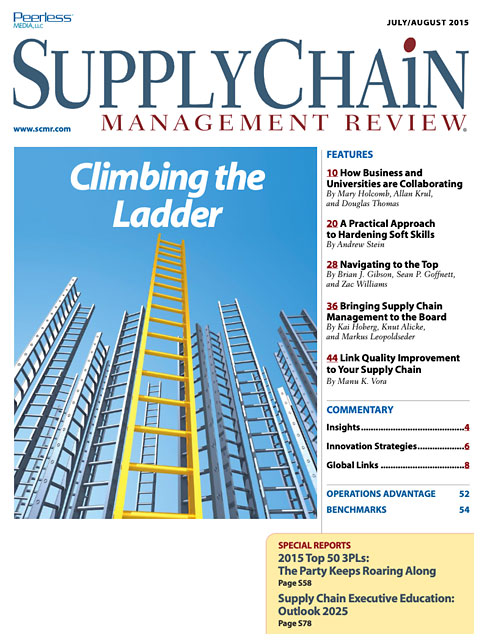Sorry, but your login has failed. Please recheck your login information and resubmit. If your subscription has expired, renew here.
July/August 2015
When it comes to career development, supply chain managers have to execute a bit of jiu jitsu. They’re charged with nding and developing the next generation of talent while simultaneously advancing their own careers in a eld that is often overlooked by senior management. The biggest challenge of all is getting their agenda in front of the Board at a time when supply chain operations are more critical than ever to an organization’s success, but still largely invisible compared to sales, marketing, and product development. Remember: It’s your career—and your supply chain. We hope this month’s issue will help you make the most of both. Browse this issue archive.Need Help? Contact customer service 847-559-7581 More options
While the glamour cities of New York, Boston, Los Angeles, and San Francisco may continue to attract the best and the brightest, a new generation of supply chain professionals may find that “second tier” urban centers in this country are becoming increasingly popular with Fortune 500 companies.
According to new research from The Hackett Group, Inc., scores of mid-size U.S. cities and outlying suburbs now represent viable alternatives to offshore locations as well.
Researchers say this is particularly true for companies keen to consolidate finance, IT, and other global business operations. The diminishing gap in labor costs, combined with factors such as lower turnover rates, greater business knowledge, proximity to customers and headquarters, and state tax incentives makes this proposition even more alluring.
 |
This complete article is available to subscribers
only. Click on Log In Now at the top of this article for full access. Or, Start your PLUS+ subscription for instant access. |
SC
MR
Sorry, but your login has failed. Please recheck your login information and resubmit. If your subscription has expired, renew here.
July/August 2015
When it comes to career development, supply chain managers have to execute a bit of jiu jitsu. They’re charged with nding and developing the next generation of talent while simultaneously advancing their own careers… Browse this issue archive. Access your online digital edition. Download a PDF file of the July/August 2015 issue. |
Download Article PDF |
While the glamour cities of New York, Boston, Los Angeles, and San Francisco may continue to attract the best and the brightest, a new generation of supply chain professionals may find that “second tier” urban centers in this country are becoming increasingly popular with Fortune 500 companies.
According to new research from The Hackett Group, Inc., scores of mid-size U.S. cities and outlying suburbs now represent viable alternatives to offshore locations as well.
Researchers say this is particularly true for companies keen to consolidate finance, IT, and other global business operations. The diminishing gap in labor costs, combined with factors such as lower turnover rates, greater business knowledge, proximity to customers and headquarters, and state tax incentives makes this proposition even more alluring.
 |
SUBSCRIBERS: Click here to download PDF of the full article. |
SC
MR

Latest Supply Chain News
- Joseph Esteves named CEO of SGS Maine Pointe
- Employees, employers hold divergent views on upskilling the workforce
- April manufacturing output slides after growing in March
- Q1 sees a solid finish with positive U.S.-bound import growth, notes S&P Global Market Intelligence
- World Trade Centers offers a helping hand to create resilient, interconnected supply chains
- More News
Latest Podcast

 Explore
Explore
Topics
Latest Supply Chain News
- Joseph Esteves named CEO of SGS Maine Pointe
- Employees, employers hold divergent views on upskilling the workforce
- April manufacturing output slides after growing in March
- Q1 sees a solid finish with positive U.S.-bound import growth, notes S&P Global Market Intelligence
- World Trade Centers offers a helping hand to create resilient, interconnected supply chains
- 6 Questions With … Sandeep Bhide
- More latest news
Latest Resources

Subscribe

Supply Chain Management Review delivers the best industry content.

Editors’ Picks






